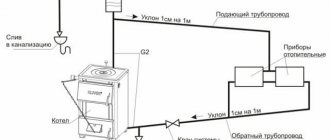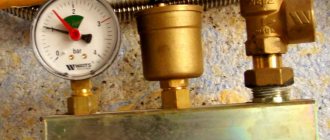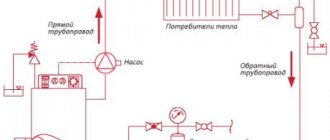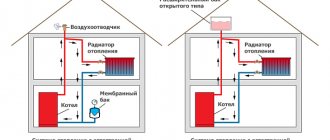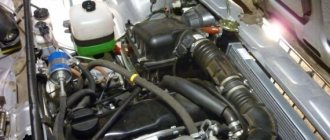Reason 1. Dumping excess air
During the first start-up, air gradually leaves the system. Therefore, the pressure in the heating system drops . Initially, it comes out of the boilers themselves. And since there are automatic air vents on the boilers and inside the boilers, usually on the walls, the air comes out of the boilers on its own.
Plus, when you start a wall-mounted boiler, there is a screw on the boiler pump that serves to bleed air right down the middle of the pump. If you unscrew it, air will come out first. Then water will flow in a thin stream. After this, you need to lightly tighten the screw, usually it is on a rubber band, and after that the wall-mounted boiler will not contain air and will be able to function normally.
Often, upon first start-up, the pressure in the heating system of water heated floors drops significantly. Huge floors can be one hundred or two hundred square meters in size. Below them are long pipes that initially contain air. Subsequently, they are filled with coolant. So when you start the heated floor circulation pump, the automatic air vents that are located on the heated floor manifold immediately begin to hiss. Those. The coolant that begins to circulate through the water-heated floor begins to push this air into the collector. And as a result, air begins to flow out of the air vents intensively, especially at the very beginning. This causes the pressure in the heating system to drop.
It is imperative to monitor the pressure on the safety group and on the pressure gauge of the wall-mounted boiler, and if necessary, top it up. Air may be escaping from the boiler coil. It can also break through to an automatic air vent. And possibly to radiators on other floors. It will accumulate in radiators, so they must have Mayevsky taps. If you see that the radiator has stopped heating, open the Mayevsky tap. At first the air will also hiss, then water will flow in a thin stream. This means that the air has completely escaped.
After the start of operation, for another week or two, maybe longer, air may escape from the water-heated floor. Accordingly, the pressure in the heating system will drop. This should not scare you, because over time the intensity will subside and after a few weeks it will practically stop.
Why does the fall occur - reasons
Sometimes it happens that the pressure constantly drops. Of course, you can ignore it and just feed the system occasionally. But these are short-term measures. It is better to determine the cause, since the consequences of low pressure can be disastrous.
Important! It is not necessary to contact specialists. Most of the reasons are easy to identify and eliminate on your own.
A leak
A leak is an unplanned decrease in the volume of coolant. This usually happens because the joints are not tight enough or welded incorrectly.
Sometimes a leak can be detected visually. It is enough to look at all the connections in the heating. If everything looks normal, you will have to turn off the heating and check differently.
To do this you will need:
- Turn off the boiler.
- Wait until the system cools down completely.
- Turn off the taps on the radiators.
- Raise the pressure to 1.5 bar.
- Turn on the boiler.
If there are two heating wings, check one first, then the other. Now all that remains is to monitor the pressure. If it falls, the cause is the boiler or pipes.
If the pressure remains within normal limits, you need to open the taps at each radiator one by one. The reason is one of them.
Attention! Sometimes leakage occurs due to corrosion of the metal when it comes into contact with air. Therefore, it is not recommended to drain water from heating in summer.
Water may leak through threaded connections. Then they need to be tightened or the gasket replaced. Sometimes the taps leak.
In this case, you will have to install new ones. If water escapes through welding joints, you can use cold welding. If it is a polypropylene seam, you will have to desolder and resolder the fitting.
Cracks
Nowadays, in most cases, pipes made of polypropylene or cross-linked polyethylene are used for heating.
Metal and metal-plastic pipes are also installed, but much less frequently. Cracks almost never occur on them. But the radiators and heat exchanger in the boiler may crack.
Identifying a crack in a radiator is easy. Water will leak out of it.
Even if there is no puddle underneath, smudges will still appear. If the radiator is sectional, this will not cause any special costs.
Of course, you will have to remove it and unscrew it, but only the broken sections will need to be replaced. If the radiator is a panel one, you will have to replace it completely. Or try brewing it.
Reference! To see the crack in the heat exchanger, you will have to disassemble the boiler. To do this you will need a screwdriver or torx. It all depends on the model.
First you need to remove the front cover. In non-turbocharged boilers, the combustion chamber is open, so it is easier to get to the heat exchanger. But a closed chamber does not cause any particular difficulties.
We recommend: Screen for a radiator: 80 photos of the best tips on how to properly hide a heating radiator
Now you need to inspect the heat exchanger. Usually, in the place where the crack is located, the metal oxidizes and acquires a greenish tint.
If there is one, then the heat exchanger needs to be changed . Sometimes it is possible to weld a crack using a gas torch , but most models cannot be repaired.
Expansion tank and its bleeding
In a closed-type system, the cause of a drop in pressure in the circuit may be the failure of the expansion tank.
Symptoms:
- Frequent recharge of the system. If there is a need to additionally introduce coolant into the system at least once a week, without visible leaks, then the problem lies in the incorrect operation of the expansion tank;
- Dispersion of pressure gauge readings for different operating modes of the system. A sharp drop in coolant pressure in the system when using hot water supply also indicates a malfunction in the RB.
Pressure inside the expansion tank
To check its functionality, it is necessary to bleed the tank and check that the pressure in it corresponds to the pressure in the heating system.
Sequence of pumping actions:
- Close the shut-off valves (direct and return water supply);
- Open the fitting, drain the water until the pressure in the boiler becomes zero;
- Take readings on the expansion tank in the “open” position. The presence of condensation on the RB should not be observed;
- Pump air into the RB until liquid stops flowing from the fitting. Allow the water to drain completely from the tank;
- Release the air;
- Repeat the procedure, keeping the pressure in the RB at 1.1...1.3 bar;
- Open the shut-off valve;
- Connect the coolant to the network. Set the pressure level to 1…1.1 bar.
Air injection
If there is no special pump for RB, you can use a regular bicycle one.
Attention! Most manufacturers indicate the pressure value in the air compartment in the equipment passport. This greatly simplifies the procedure for selecting an expansion tank for the boiler.
Open tap
To fill water into the heating, use a make-up tap. It connects the water supply and the boiler. Users often forget to close it, and this is precisely why the pressure may decrease.
Important! If the boiler is double-circuit, it works both for heating and for heating hot water. In this case, the effect of communicating vessels occurs.
When hot water is not used, the pressure is normal. As soon as the mixer is opened, the pressure drops sharply. This happens because water from the heating goes into the water supply.
By the way, this can be understood by the smell that comes from the water supply. Typically, heating water does not smell very pleasant. If the make-up valve is working properly, just close it. If it is broken, you will have to change it.
Proper installation of boilers involves installing ball valves at all outlets and inlets. Therefore, you can simply turn off the water taps when not in use. But this is a short-term solution.
Air in the system
When the system is filled with water, some air may remain in the pipes.
This problem is solved by automatic drains, which are installed at the highest heating points.
Unfortunately, the air is not always removed completely. Much depends on the design of the system. For example, aluminum radiators emit hydrogen. It also comes out through the drains, but it is precisely because of this that the pressure in the system drops.
Over time, this process may slow down or disappear altogether. But at first you will have to put up with the problem. Or replace the radiators with others.
There are other reasons for the appearance of air in the system:
- Incorrect installation.
- Long downtime of heating.
- Water itself releases oxygen.
- Various chemical reactions.
Attention! Practice shows that it is impossible to achieve complete sealing of the system by any means. Air gets into the heating anyway.
Air jams
Cracks and lack of sealing in the heating system lead not only to leaks, but also to the opposite phenomenon - air being sucked into the circuit. As a result, air bubbles form in it. Some of them are eliminated by air bleeders, but they are not present in all systems. If the pressure in the system drops, there is probably a strong airing of the heating.
Air bubbles can also form as a result of improper filling of the circuit - air pockets form in it, due to which the pressure in the heating system drops. Airing causes many other phenomena:
- Gurgling and murmurs traveling through pipes are sound effects caused by air bubbles;
- Cold batteries and pipe sections - not only the pressure drops, but also the heating efficiency;
- Metal corrosion – the presence of air in the heating system leads to the thinning of metal components.
Thus, banal deaeration of the system will help to increase the pressure in the boiler.
Relief valve malfunction
The operating principle of a spring safety valve designed for an individual heating system.
The relief (safety) valve is part of the safety group or installed separately; it is necessary to relieve excessive pressure in the heating system. The principle of its operation is as follows: the spring presses on the valve, which blocks the flow of coolant, but as soon as the pressure exceeds the permissible limits, the spring compresses, opening the valve and releasing excess air or coolant.
After 7-10 cycles, spring relief valves fail due to wear of the spring, which no longer holds the same pressure: it jumps or decreases. In this case, there is a constant leak.
It is strongly not recommended to disassemble and repair the relief valve yourself; it is better to simply replace the mechanism. The issue price is only 500-900 rubles.
Faulty pressure gauge
If the system is working normally, but the pressure readings are still below normal, the cause may be a broken pressure gauge. Usually his arrow just stays in one place. Although it also happens that she continues to move. It can be difficult to understand this visually, so the pressure gauge needs to be removed.
Reference! You cannot unscrew the pressure gauge while holding it by the body. For these purposes, use a fitting and a regular wrench.
If the pressure gauge is unscrewed and it continues to show pressure, then it is faulty. They usually have a very thin entrance that can simply become clogged. In some cases it is enough to clean it, but sometimes it is easier to replace it.
Use of aluminum radiators
Aluminum radiator
One of the serious disadvantages of an aluminum radiator is increased gas formation when interacting with a water flow. Water, entering into a chemical reaction with aluminum, causes its oxidation, which results in the release of hydrogen. This process is actively occurring in the new device. After a certain period of time, the oxidation reaction subsides and gas evolution stops.
Reason 2. Air is escaping from the expansion tank
A few months after the start of operation, the pressure in the heating system may drop unpredictably when air leaves the membrane expansion tank. There is a nipple at the top of the tank, which gradually, over the course of perhaps several months, bleeds the air. And it turns out that under the influence of the coolant, all the air is squeezed out and the entire expansion tank is filled with coolant.
This is due to the fact that when the boiler is turned on, the coolant heats up, the pressure in the system quickly begins to increase, and the following happens: when the pressure becomes higher than permissible, the safety valve is activated and relieves the pressure. And when the pressure decreases, you gradually feed it, and this happens more and more often. And a condition imperceptibly occurs in the expansion tank when the entire or almost the entire tank is filled with coolant (water) and there is practically no air in it. Consequently, the pressure rises when the boiler starts operating, and as soon as it rises above the limit, the safety valve, which is precisely designed to protect the system, is activated, and the coolant is discharged. Accordingly, the pressure in the heating system drops.
How to check the pressure?
Pressure can be checked using a pressure gauge
Each boiler has a pressure gauge that displays the pressure of the heating system. The initial setup is carried out by a representative of the company with which an agreement was concluded for the installation and maintenance of gas equipment. As the temperature of the coolant increases, the pressure also increases. If gas is added, but the pressure does not increase (the system itself does not maintain the set pressure), then you need to look for the reasons.
The pressure sensors in each boiler are different, as are the recommended parameters. In the instruction manual you can find all the recommendations regarding the normal pressure gauge values.
The control sensor can be displayed on a common display or located inside the structure. In any case, it performs the only function - monitoring the pressure in the system, and if it is low, then heating, or rather the lack of heat, will make itself felt.
Reason 3. Leak in the heating system
And, of course, the most unpleasant case of loss of pressure in a heating system is a leak. It can be either in a visible place or appear somewhere where it is difficult to visually detect. Regardless of its location, it will sooner or later make itself felt.
For example, if a leak occurred inside a water-heated floor. This happens when someone accidentally drills into his branch, either from above or below. This is easy to detect, because a stain immediately appears or even water gushes out like a fountain. To eliminate this problem, it is necessary, of course, to carefully disassemble the floor at the leak site, install the necessary coupling, and, upon completion of the installation, re-cement this area.
Preventing the formation of air jams
Preventative measures against the occurrence of air locks are as follows:
- Pay attention to the correct installation of pipes and connections of heating devices. Many problems are caused precisely by mistakes made at this initial stage.
- To prevent air locks, proper commissioning of the equipment is necessary, before which it is important to first check all components and connections.
- Before putting devices into operation, check them for functionality. Using a compressor, you need to apply a pressure level that is ¼ higher than its normal operating value. If it does not weaken within 30 minutes, then everything is in order and the system is ready for operation. If the pressure drops sharply, then leaks are possible, which should be promptly identified and repaired before starting operation.
We recommend: Do-it-yourself heating (heating) of a greenhouse: 8 best projects
Examples of pressure drop in a heating system
Example one
Let's say you come in between pump operation and see that the pressure has dropped. We fed it to the standard position. And they left. Next, the boiler completed a one-time operation cycle, heated up and cooled down, and you may not even know that at this time the safety valve was activated. And without knowing this, you again have to replenish the pressure, without understanding the true reason for what happened to the coolant and why the pressure drops so quickly.
Example two
For the second example, let's give an even more specific case. There is an indirect heating boiler, made by the German company Vaillant, the coil installed in it has leaked in some unidentified area. And there was a merger between the area of sanitary water and the area with coolant water. This leads to the fact that when the sea pressure in the water supply system is high, the sanitary water enters the coolant area and the pressure in the system increases. And when the pressure of sanitary water decreases, the pressure in the heating system drops along with it.
Unfortunately, the only way out of this situation is to completely replace the indirect heating boiler.
Example three
For the third example, we will consider double-circuit heating boilers. One of the most common reasons why the pressure in the heating system drops is the initially incorrect choice of boiler size. This is one of those cases when instead of small heating radiators, which differ in the size of the stored coolant, pipes are installed that use a much larger amount of water. And this fact is not taken into account when initially taking into account the required area of the premises in which heating will be carried out.
Consequently, in the calculations made by you, exactly the same error will lead to a drop in pressure in the heating system.
What other reasons are possible?
Several other reasons deserve mention that will affect the pressure drop in the heating system.
- If the coolant used is leaking at the intersection of pipelines;
- corrosion (places affected by rust);
- poor quality work when installing the heating system;
- the appearance of microcracks on the boiler heat exchanger;
- or a rupture of the membrane of the already mentioned expansion tank;
- failure of the boiler automation (this only happens after a long period of operation).
A malfunction noticed in a timely manner or avoided altogether will provide your home or apartment with the constant necessary heat, which will be provided by uninterrupted and stable pressure in your heating systems
